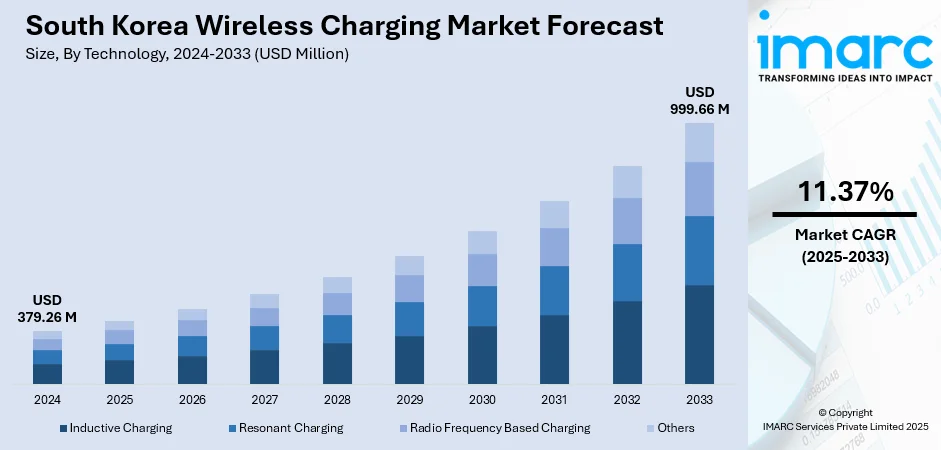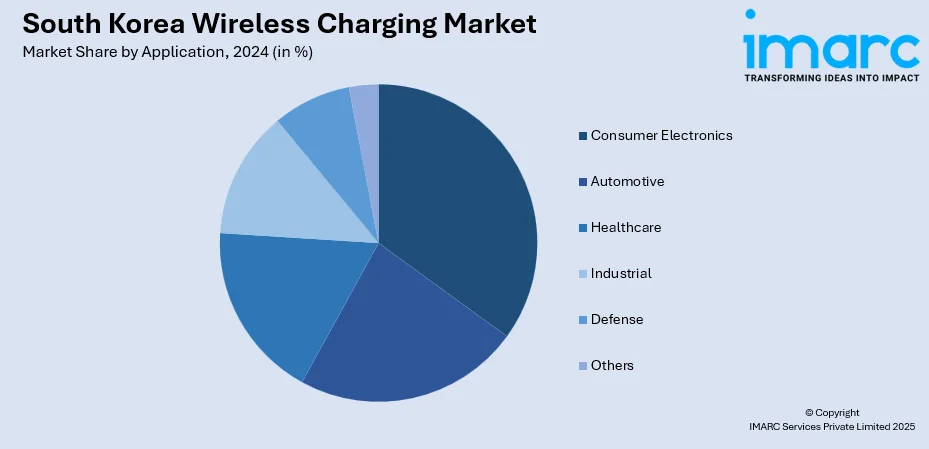
South Korea Wireless Charging Market Size, Share, Trends and Forecast by Technology, Transmission Range, Application, and Region, 2025-2033
South Korea Wireless Charging Market Overview:
The South Korea wireless charging market size reached USD 379.26 Million in 2024. Looking forward, the market is expected to reach USD 999.66 Million by 2033, exhibiting a growth rate (CAGR) of 11.37% during 2025-2033. The market is fueled by the synergy of cutting-edge technological infrastructure, high consumer aspirations for convenience, and the availability of renowned electronics players such as Samsung and LG. Support from the government for smart mobility and sustainable transport systems also spurs the adoption of wireless power, especially among electric vehicles and public transportation. Incorporation of wireless technology in smart cities and public facilities is also responsible for long-term growth, further contribute to the growth of South Korea wireless charging market share.
|
Report Attribute
|
Key Statistics
|
|---|---|
|
Base Year
|
2024
|
|
Forecast Years
|
2025-2033
|
|
Historical Years
|
2019-2024
|
| Market Size in 2024 | USD 379.26 Million |
| Market Forecast in 2033 | USD 999.66 Million |
| Market Growth Rate 2025-2033 | 11.37% |
South Korea Wireless Charging Market Trends:
Technological Leadership in Consumer Electronics
South Korea's status as a world leader in electronics decisively influences its wireless charging industry. Indigenous titans such as Samsung Electronics and LG Electronics made the Qi-standard wireless charging mainstream and kept advancing in terms of efficiency, power delivery, and integration. Their efforts are supported by local demand: South Korean consumers love early adoption of new technology, from smartphones to wearables, and expect easy wireless convenience. This combination of consumer expectations and manufacturer innovations has provided rich soil for high-wattage chargers and multi-device pads to thrive. In addition, leading semiconductor capabilities, particularly in inductive-charging ASICs, drive both device-level innovation as well as national competitiveness. The alignment of strong R\&D infrastructure, consumer appetite for cutting-edge gadgets, and mass‑market readiness gives South Korea a distinct edge in the global wireless charging landscape, which further fuels the South Korea wireless charging market growth.

To get more information on this market, Request Sample
Government Policy and EV Ecosystem Synergy
Beyond the consumer electronics arena, South Korea’s government plays a strategic role in nurturing wireless charging infrastructure through smart‑grid policies, EV subsidies, and urban mobility initiatives. Public transportation electrified shows this up sharply: Kaist's Online Electric Vehicle (OLEV) infrastructure accommodates inductive charging pads, shown by wirelessly charged buses running on Gumi and Sejong city streets, and a follow-on line opened in Yuseong in 2019. These pilots demonstrate an even larger aspiration—to integrate wireless power into smart city infrastructure and EV networks. Legislation that promotes residential EV charger installation in new dwellings, as well as tax breaks to environmentally friendly manufacturers, further spur wireless adoption. South Korea's initiative toward dynamic charging technologies, cars that charge as they drive, draws on this broader momentum toward green, networked infrastructure, frequently supported by nimble deregulation and public‑private partnerships.
Smart Urbanization and Specific Regional Applications
Hyper-localized innovations derived from urban planning and smart infrastructure characterize South Korea's wireless charging industry. KAIST's Gumi bus initiative, for example, installs induction plates embedded in the road to charge buses in transit with up to 85% efficiency along only a short portion of their route—an innovation previously celebrated among "Time's 50 Best Inventions of 2010". Outside of transport, wireless power has been rolled out into public spaces: warmed bus-stop benches with phone charging pads are not hard to find in big cities, representing civic-scale innovation distinct to the region. Furthermore, Korea's ultra‑high‑speed internet and smart‑grid backbone facilitate real‑time energy management, paving the way for sophisticated applications such as dynamic EV charging lanes and smart home wireless ecosystems. This city-scale, infrastructure-led strategy—through high-density networks, tight planning, and social cohesion, is what makes South Korea such a top-notch laboratory for next‑gen wireless charging.
South Korea Wireless Charging Market Segmentation:
IMARC Group provides an analysis of the key trends in each segment of the market, along with forecasts at the country and regional levels for 2025-2033. Our report has categorized the market based on technology, transmission range, and application.
Technology Insights:
- Inductive Charging
- Resonant Charging
- Radio Frequency Based Charging
- Others
The report has provided a detailed breakup and analysis of the market based on the technology. This includes inductive charging, resonant charging, radio frequency based charging, and others.
Transmission Range Insights:
- Short Range
- Medium Range
- Long Range
The report has provided a detailed breakup and analysis of the market based on the transmission range. This includes short range, medium range, and long range.
Application Insights:

- Consumer Electronics
- Automotive
- Healthcare
- Industrial
- Defense
- Others
A detailed breakup and analysis of the market based on the application has also been provided in the report. This includes consumer electronics, automotive, healthcare, industrial, defense, and others.
Regional Insights:
- Seoul Capital Area
- Yeongnam (Southeastern Region)
- Honam (Southwestern Region)
- Hoseo (Central Region)
- Others
The report has also provided a comprehensive analysis of all the major regional markets, which include Seoul Capital Area, Yeongnam (Southeastern Region), Honam (Southwestern Region), Hoseo (Central Region), and others.
Competitive Landscape:
The market research report has also provided a comprehensive analysis of the competitive landscape. Competitive analysis such as market structure, key player positioning, top winning strategies, competitive dashboard, and company evaluation quadrant has been covered in the report. Also, detailed profiles of all major companies have been provided.
South Korea Wireless Charging Market News:
- In November 2024, the previous Samsung Electronics division, recognized for its innovations in NFC and wireless charging for smartphones and wearables, revealed that it is now promoting new advancements in wireless chargers for electric vehicles.
- In February 2024, at CES, WiTricity showcased wireless charging technology for electric golf carts. Numerous individuals visited the booth as they had heard of wireless EV charging but had never witnessed it in operation. Wireless charging for electric vehicles was emphasized by videos displaying different EVs charging wirelessly, alongside other vehicles in our exhibit.
- In March 2025, by increasing the allowable output from 50W to 1kW, the Ministry of Science and ICT relaxed the certification standards for wireless chargers used in ICT equipment such as commercial and industrial robots. Additionally, location-based installations no longer require permits. A model-based conformance evaluation may now be used to certify products, allowing businesses to adopt the technology more quickly and easily.
South Korea Wireless Charging Market Report Coverage:
| Report Features | Details |
|---|---|
| Base Year of the Analysis | 2024 |
| Historical Period | 2019-2024 |
| Forecast Period | 2025-2033 |
| Units | Million USD |
| Scope of the Report | Exploration of Historical Trends and Market Outlook, Industry Catalysts and Challenges, Segment-Wise Historical and Future Market Assessment:
|
| Technologies Covered | Inductive Charging, Resonant Charging, Radio Frequency Based Charging, Others |
| Transmission Ranges Covered | Short Range, Medium Range, Long Range |
| Applications Covered | Consumer Electronics, Automotive, Healthcare, Industrial, Defense, Others |
| Regions Covered | Seoul Capital Area, Yeongnam (Southeastern Region), Honam (Southwestern Region), Hoseo (Central Region), Others |
| Customization Scope | 10% Free Customization |
| Post-Sale Analyst Support | 10-12 Weeks |
| Delivery Format | PDF and Excel through Email (We can also provide the editable version of the report in PPT/Word format on special request) |
Key Questions Answered in This Report:
- How has the South Korea wireless charging market performed so far and how will it perform in the coming years?
- What is the breakup of the South Korea wireless charging market on the basis of technology?
- What is the breakup of the South Korea wireless charging market on the basis of transmission range?
- What is the breakup of the South Korea wireless charging market on the basis of application?
- What is the breakup of the South Korea wireless charging market on the basis of region?
- What are the various stages in the value chain of the South Korea wireless charging market?
- What are the key driving factors and challenges in the South Korea wireless charging market?
- What is the structure of the South Korea wireless charging market and who are the key players?
- What is the degree of competition in the South Korea wireless charging market?
Key Benefits for Stakeholders:
- IMARC’s industry report offers a comprehensive quantitative analysis of various market segments, historical and current market trends, market forecasts, and dynamics of the South Korea wireless charging market from 2019-2033.
- The research report provides the latest information on the market drivers, challenges, and opportunities in the South Korea wireless charging market.
- Porter's five forces analysis assist stakeholders in assessing the impact of new entrants, competitive rivalry, supplier power, buyer power, and the threat of substitution. It helps stakeholders to analyze the level of competition within the South Korea wireless charging industry and its attractiveness.
- Competitive landscape allows stakeholders to understand their competitive environment and provides an insight into the current positions of key players in the market.
Need more help?
- Speak to our experienced analysts for insights on the current market scenarios.
- Include additional segments and countries to customize the report as per your requirement.
- Gain an unparalleled competitive advantage in your domain by understanding how to utilize the report and positively impacting your operations and revenue.
- For further assistance, please connect with our analysts.
 Request Customization
Request Customization
 Speak to an Analyst
Speak to an Analyst
 Request Brochure
Request Brochure
 Inquire Before Buying
Inquire Before Buying




.webp)




.webp)












